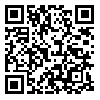Volume 23, Issue 2 (Apr-May 2015)
JSSU 2015, 23(2): 1905-1914 |
Back to browse issues page
Abstract: (5191 Views)
Introduction: Fissure sealant is the most effective method to prevent occlusal surface caries of posterior teeth . In recent years, the use of laser for enamel surface pretreatment has been considered as an effective method before applying fissure sealant. Hence, the aim of this study was to investigate the effect of Er:YAG laser conditioning on fissure sealant microleakage.
Methods: In this experimental study, total of 60 extracted third molars were randomly assigned into four groups(n=15). The occlusal surfaces were sealed with a sealant (clinpro) after one of the following pretreatments:
1- Phosphoric acid etching + total etch bonding, 2- Laser + self etch bonding, 3- Laser + total etch bonding, 4- Laser + Phosphoric acid etching + total etch bonding. The parameters of used laser was 120 mj energy and pulse duration of 250-500 µs with frequency 4 Hz. After sealing, the teeth were thermocycled at 500 cycles and immersed in methylen blue 1% for 24 hours. The teeth were then sectioned buccolingually and examined for microleakage. Statistical analysis were preformed via applying Kruskal-Wallis and Mann-Whitney.
Results: The study results indicated significant differences between 4 groups (p<0.05) except for groups 1 and 4 (p=0.3). Moreover, the highest microleakage was observed in group 3, whereas the lowest was reported in group 4.
Conclusion: It seems that conventional acid etching technique is the best and simplest method of Sealant therapy.
Type of Study: Original article |
Subject:
Pediatrics
Received: 2014/07/9 | Accepted: 2014/11/17 | Published: 2015/05/3
Received: 2014/07/9 | Accepted: 2014/11/17 | Published: 2015/05/3
| Rights and permissions | |
 |
This work is licensed under a Creative Commons Attribution-NonCommercial 4.0 International License. |


